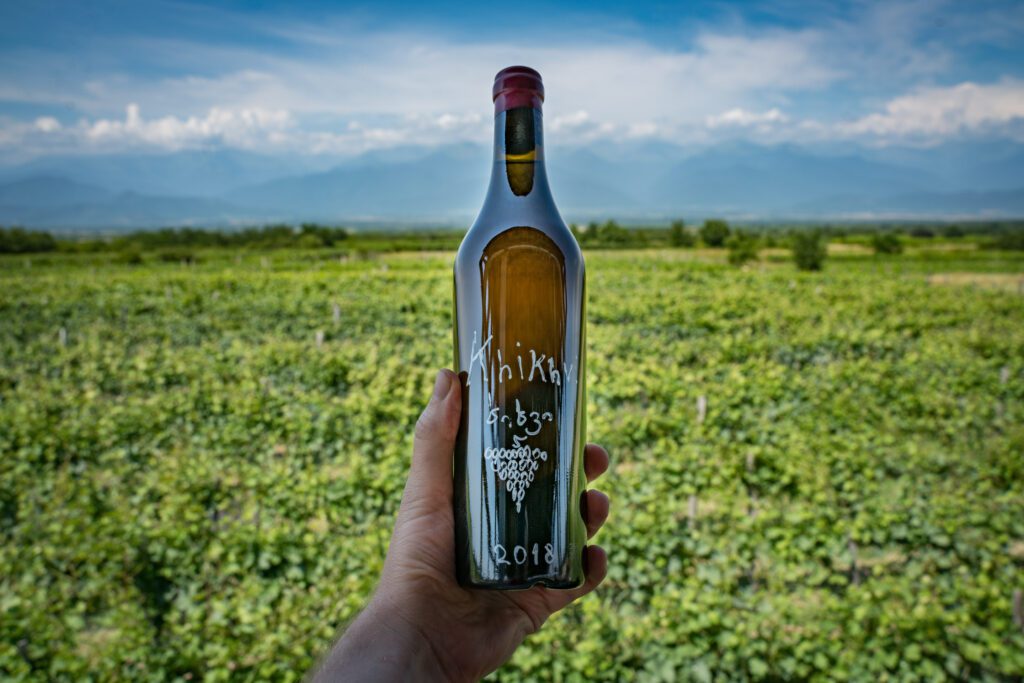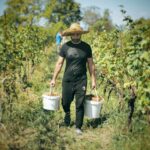In this article I compare Georgia Wine Tours from Tbilisi and Kutaisi as well as offer a summary to the major Georgian wine regions and wines. Should you take a Kakheti wine tour (Georgia’s most famous wine region), or head to one of the lesser known regions? Which wine regions are easiest to reach from Tbilisi, Kutaisi, or Batumi?
What factors effect whether the Georgian wine tour you take is right for you and your budget? Guided vs Independent Tours: and how to do either in the best way.
Artisan vs commercial. Premium vs budget. What is the difference? And how can you spot if the more expensive tours are actually worth the money and taking you to premium places, or not?
From my experience visiting 170+ wineries in Georgia, since 2016, I explain every part of the Georgian wine tour and tasting experience, from simple wine tasting in a shop, bar or factory through to sitting down with the winemaker and having a supra (Georgian feast) sharing stories and toasts of Georgia’s cultural history while enjoying homemade food and their artisan wines.
Georgia’s connection to wine traverses 8000 years of living history. The qvevri (amphora) winemaking method (UNESCO intangible heritage) persists from its origins to form the quintessential part of modern artisan winemaking and hospitality. On a Georgian wine tour, you should discover this history and the wines that accompany it, as well as the cultural traditions.
If you head to Georgia’s wine regions and only visit commercial factories, you will miss out on the most engaging elements of Georgia’s wine culture. This is not to say that large producers do not offer some quality wines that should be tasted, just that to explore the puzzle with only the most accessible pieces, is to miss out on what really makes Georgia a phenomenal wine destination.
Wine Tours In Georgia: Not Just Another Blogger Review
I have written this article very much from experience – having visited more than 170+ Georgian wineries (and more all the time) since 2016, as well as tasting a significant volume of other Georgian wines at a myriad of wine festivals and wine bars in Tbilisi and beyond.
I have a WSET 2 – distinction (96%) – qualification, and have been working closely with a local wine school in Tbilisi on finalizing my Georgian sommelier wine education as well as coordinating with Georgian sommeliers frequently on assessing wines and wineries.
This is not a quick blog post based on spending a couple of days trying a few easy-to-find wine factories in Kakheti (Georgia’s largest wine region), or taking just 1 Georgian wine tour. This is a comprehensive summary of years spent as a foreigner immersing myself in Georgian wine (and food) culture, and exploring off-track wine regions – as well as the more famous ones.
Tasting rare grapes (less than 100 bottles made type wines) that have barely been rediscovered yet by Georgians, let alone foreigners – you won’t be seeing these grapes in your local supermarket, or even in a Georgian artisan wine shop in Tbilisi.
You have to go to the Georgian vineyards yourself!
And I’ll tell you how below…
That said, such a level of immersion is too much for the casual wine enthusiast, so this guide is designed to help typical wine tourists scratch beneath the surface of the mass tourism Georgian wine tours that are pedaled on every street corner of old Tbilisi. Instead, you should meet the winemakers, access fine artisan wines and true Georgian hospitality.
Whether taking a Georgian wine tour, or trying to figure out a way to explore independently, this article will help you get the lay of the land regarding how wine tourism in Georgia works – trust me, there are quirks and surprises, but that is part of the joy of exploring a country that is still developing their tourist infrastructure.
Authenticity is rampant when you know where to look, and I love it! So will you!
If you are in the 5% of people who want to go deeper (winemakers, journalists, bloggers, sommeliers and wine experts etc.), that is possible too but it’s best to contact us directly and let us know your interests, so we can chat about specialist options.
Georgian Wine Tours Summary – Quick Links & Intro
In a hurry? Skip the rest of the article, just read this section.
Shortlist of the Best Georgian Wine Tours
- Eat This! Premium Authentic Food & Wine Tours. Premium artisan wines, exceptional experiences and food, tasting/wine pairing menu, real supra (feasts). Indulgent, interactive and personal small group tour experiences.
- Traffic Travel Tours. Traditional home-cooked food, decent family wine and hospitality as well as typical commercial visits. A taste of Georgian wine culture, but not the whole hog.
- Gamarjoba tours. Commercial wineries (Khareba & Kindzmaruli Corporation), larger group but cheap. Meet people, fun day out, limited experience with traditional restaurant food and corporate wine (see my notes on the difference between “artisan”, “factory” and “home” wine below).
- Independent cheaper but self-guided: Hop a minibus or self-drive to Signagi or Telavi and visit one of the easy-to-find wine rooms (Signagi: Okros, Cradle of Wine, Mtevani. Telavi: Milorauli, Vazivani, Vino Ponto, Sesikeli) which are walking distance within the town centers (to avoid drunk driving!). More suggestions and transport options discussed below.
How Long Do I Need To Spend In Wine Country?
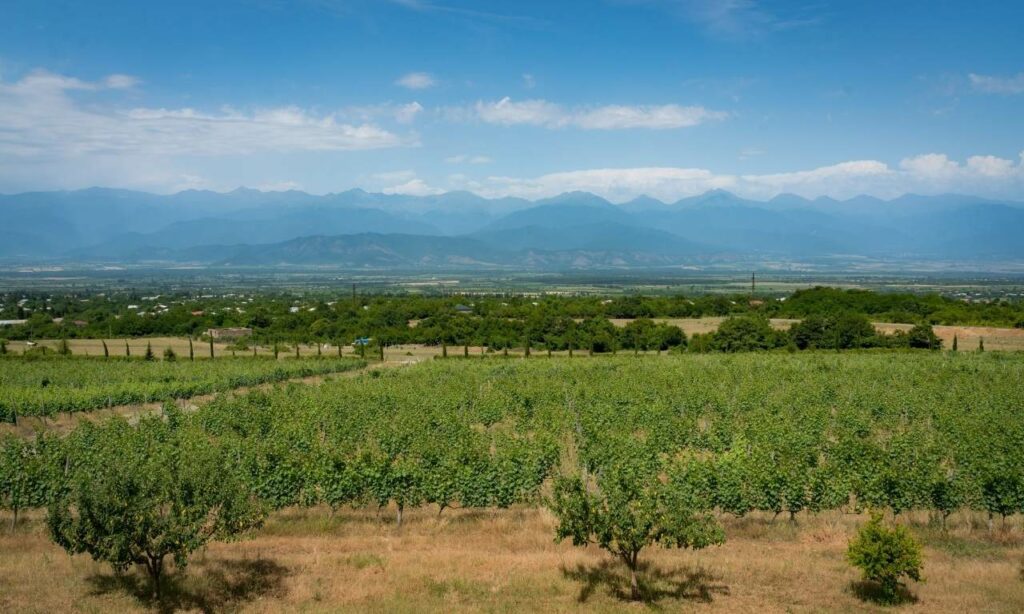
- A one-day wine tour from Tbilisi to Kakheti is enough to get a taste for Georgian wine and explore a little variety. 8 hours is really the minimum as getting to Signagi or Telavi is a 4 hour roundtrip drive. I’d suggest 12 hours to actually have a decent amount of time at wineries.
- A half day (4 to 6 hour) wine tour is possible if heading just to the border of Kakheti (Khashmi, 45 minutes from Tbilisi) or visiting Mtskheta/Kartli area instead. 1 winery for lunch, or 2 wineries (1 lunch, 1 for tasting only), is possible in this time.
- For real wine enthusiasts, 2 to 3 days is better to explore differing microzones (appellations), regions and wine styles and get way more depth of understanding and variety.
- 10 days is a minimum to explore a little of all the major wine regions. But also your liver may hurt if doing this all at once. It’s better to make Tbilisi your base and do 2 to 3 trips over the course of a couple of weeks or more.
The Shortest (and Wildly Insufficient) Summary of Georgian Wine History, Ever
- The earliest evidence of winemaking in the world was discovered in Georgia. Carbon dated to 6000 BC.
- They still make wine today following the same 8000-year-old method: making wine in a qvevri (tear-shaped clay amphora). But with some better hygiene standards.
- Georgian qvevri wines are typically made with extended skin contact. This causes white wines to be an amber color, and leads to some very different characteristics compared to European classical wines.
- The Soviet occupation in the 20th century messed up the wine industry. Since 2006 artisan wine production has started to recover and now is having a renaissance.
- Georgia has over 500 endemic grape varieties. These grow across many wine regions, the most popular being Kakheti, 1 hour east of Tbilisi.
Interested to learn more? A fuller version is below. Or, ready to book a tour – skip the wine and culture info and read our tour comparison below.
Georgian Wines In A Nutshell – History, Wine Style.
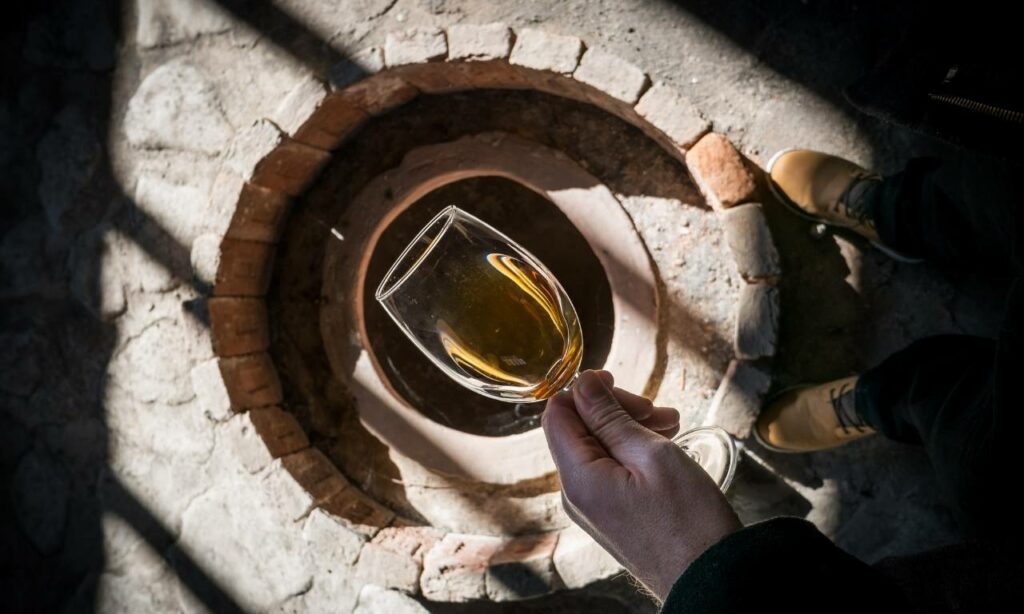
Ok, if you made it this far, you are looking for some more detail. Though this is still just a summary, it’s a great start!
If you are looking for a Georgian wine tour, chances are you already read just a little bit about Georgian wine, so this is the briefest summary I can provide so you can get the gist of the essentials. Once you go on tour you will learn a lot more, especially if you head out with an expert guide or sommelier and meet the winemakers in person.
Georgian Wine History In Brief(ish).
- The earliest evidence of winemaking in the world was discovered at the Gadchrili Gora archeological site, 20 miles south of Tbilisi (there is no visitors center currently, so not anything to visit).
- The wine “stained” pottery was carbon dated to ~6000 BC. So when you hear about 8000 vintages, that is because wine has likely been made every year for at least 8000 years in Georgia. Production was, of course, perpetuated on a small scale in homes and villages during the bulk of that time.
- Fast forward to 1011 AD and the monastic tradition of winemaking is flourishing, with records showing winemaking at Alaverdi monastery in Kakheti, following its expansion being completed at that time. Likely wine was made on this site before this but 1011 is the year they claim was the beginning of unbroken production for over 1000 years. You can visit on a Kakheti wine tour.
- Following annexation by Russia in 1801, Alexander Chavchavadze constructed a stately mansion near Telavi. Having spent time in Europe, he decided to start bottling Georgian wines in glass, as previously they were stored in qvevri (clay amphora) as they had been since 6000 BC.
- In the late 19th century phylloxera plagued the country, and much of the world, destroying the vast majority of Georgian vines. Some rare varieties may have been lost. Replanting with phylloxera resistant rootstocks began in earnest.
- In 1918 Georgia gained it’s independence from Russia, but lost it again in 1921 as the Soviet Union rose to power.
- Though significant replanting was performed by the Soviet government, their goal was quantity, not quality. They chose to replant only the hardiest, highest-yielding grape varieties. This destroyed the diversity of Georgian viticulture.
- In 1991 Georgia gained independence when the Soviet Union collapsed. The country, and the wine industry, were in tatters for more than a decade.
- In the early 2000s, things began to recover. Larger wineries led the charge, but still with less focus on the highest quality. Some small independent wineries began to pop up but struggled with funding.
- At the time Russia was still the biggest importer of Georgian wine. In 2006, a ban on imports to Russia forced Georgian winemakers to rethink their strategy. Instead of the historical tendency of bulk wines for mass export, a new focus on quality and diversifying to higher quality-driven markets like the US, Japan, UK etc. became essential.
- Since 2006 the artisan, bio, and fine wine direction of Georgia has grown exponentially. The number of producers even since my first visit in 2016, has exploded. The organic wine renaissance, using 8000-year-old methods, is here. There are still mixed results, but once you know where to look, uniqueness and quality is very much available.
- Today Georgia has 500+ endemic grape varieties. Many are not suited to wine. The majority of all wine production still focuses on Rkatsiteli (white), Saperavi (red) and Mtsvane (white) though there is a great selection of lesser-known grapes to explore, and some very rare grapes also to discover.
Qvevri Wine (Traditional) vs. European Wine (Classical)
The qvevri is a clay amphora. Wine is fermented and aged inside, as it was 8000 years ago.
A key difference with Georgian wine is this skin contact. Georgian white (amber) wines are made with extended skin contact, whereas European classical white wines (typically steel tank production) are fermented with just the juice and no skins (or barely hours with skins).
Skin contact in amber wines can be from a few days to 6+ months, depending on the variety, the season, the terroir, and the winemaker’s preference.
The qvevri itself can impart various characteristics – compared to steel, which is inert – but the amount of effect the qvevri has depends on the type of qvevri and a lot of other factors that need a deeper discussion.
In Georgian white (amber) wines, you’ll find more tannins and a very different flavor profile from European whites. On first tasting, some people say “this is not wine!” But really, it’s the original wine. Once you discover the higher quality versions – not the budget table and homemade wines (which can often be lacklustre or have technical faults) – you’ll be surprised as to how expressive it can be.
–
For a crash course in everything you need to know to get familiar with Georgian wines, download our Georgian wine crash course. You’ll also get our wine tasting review card and guide so you can understand how to taste and appreciate Georgian qvevri wines.
Georgian Wine Podcast
We give a summary of Georgian wine, in podcast format.
Get more episodes of the Tbilisi Podcast by searching “Tbilisi Podcast” on any podcast platform.
Best Wine Regions To Visit On A Georgian Wine Tour
IN SUMMARY: First time visitors to Georgia should take a 1 or 2 day trip to Kakheti region (or Imereti if you are based in Kutaisi, though I’d suggest heading east to Kakheti if you have the time). If you have more time, and are a real wine enthusiast, then a multi day trip to a few wine regions will broaden your understanding of Georgian wine considerably.
Almost every region of Georgia has viticulture. I’ve covered an overview of all the wine regions, and their unique endemic grapes, in more depth here. For the average tourist, things are far simpler, as it really boils down to 2 options (and 4 for the more adventurous wine explorer)
Most tourists will explore from Tbilisi or Kutaisi (and some from Batumi, though there is way less infrastructure for wine tourism there).
The biggest error I see tourists make time and again is that they book accommodation in wine country, before booking a wine tour. As the majority of all wine tours in Georgia depart from Tbilisi, they can find that their options become very limited when expecting a pickup in Signagi or Telavi. It’s not impossible, but all the best guides live in and depart from Tbilisi, or Kutaisi.
Wine tours from Tbilisi: Georgian Wine Regions You can Visit on a 1 to 2 Day Trip.
The vast majority of tourists starting from Tbilisi take a 1-day wine tour to the Kakheti region. And this accounts for about 85% of wine tours in Georgia.
This should not put you off exploring Kakheti though, it is a top wine region. If you are only going to spend 1 day of your time in Georgia exploring wine, this is the best choice for most visitors.
If you are a wine enthusiast with more time and want to explore deeper, then 2 to 3 days will allow you to gain a much fuller understanding, as well as discover some of the lesser visited appellations. Also a 1 to 2-day trip of some of the smaller wine regions near Tbilisi, like Shida Kartli or Bolnisi will take you off-track to explore some very different grapes that the typical Kakheti wine tours do not offer.
Where to Stay in Tbilisi
- Rooms Hotel Tbilisi – 4 star design style hotel. On Rustaveli Avenue.
- Vinotel – 4 Star wine hotel. Across the river, opposite Tbilisi old town.
- Communal Sololaki – 4 star boutique hotel. In the Bohemian district near old town.
- Tbilisee hotel – 4 Star boutique. In Tbilisi old town.
- Shota @ Rustaveli Boutique – 4 Star boutique on Rustaveli Avenue, close to Freedom Square.
- Moxy – 3 star design hotel by Marriott. Opposite old town.
- Marani Boutique Hotel – 2.5 Star wine boutique hotel. Classic Georgian style with their own wine cellar.
Kakheti Wine Tours / Areas – Where to Visit
Kakheti is the most extensive, famous, and highest quantity wine region in Georgia – by a long way. Of Georgia’s 29 PDO appellations (also called microzones), 20 of them are in Kakheti.
Kakheti consists of two fertile river valleys. The Alazani valley, bordered to the north by the epic Caucasus mountains. 2 hours drive from Tbilis to Telavi, Kakheti’s capital.
The Iori valley is the next valley south of Alazani. This is the closest part of Kakheti, only 45 minutes from Tbilisi city center. The famous fortified mountain village of Signagi is at the junction of the Iori and Alazani, about 2 hours east of Tbilisi.
It’s possible to visit the vineyards of the Iori valley and the Alazani valley in one day, also stopping in at Signagi (the historic fortified mountain town). Alternatively, take the mountain pass across Gombori, the range that separates the two valleys, to Telavi, and visit areas of northwest Alazani.
Though it is possible to visit Telavi and Signagi in one day, to do both is really a sightseeing trip only, with brief wine stops, not a proper wine tasting trip. A longer trip to explore more of the terroir, is recommend.
Georgian Wines / Grapes From Kakheti
Kakheti is famed for its bold and tannic amber and red qvevri wines.
The specific grapes to look out for are:
- Rkatsiteli (White) – most planted in Georgia. High-yield, versatile grape. Expect apricot, yellow plum, red apple, pear, and walnut. The Kardenakhi/Tsarapi area is great for bold ambers with orange peel and walnut notes.
- Saperavi (Red) – 2nd most planted in Georgia. Dark red fruits like cherry and blackberry are typical central characters, but its profile extends in every direction. Mukhuzani & Khasmi are is famous for dry saperavi, and Kindzmaruil for sweet.
- Kakhuri Mtsvane (White). Peach, floral, citrus, and tropical fruits are common flavors.
- Kisi (White). Expect pear, citrus, stone fruit, and walnuts. Primarily dry wines.
- Khikhvi (White). Expect wildflowers, honey, and stone fruits.
Where to Stay In Kakheti
If choosing to travel independently and stay overnight, there are a lot of options.
Telavi / Tsinandali (North West)
- Tsinandali Estate – 5 Star. Radisson collection, highest standard hotel in Kakheti. With spa and pool.
- Chateau Mosmieri – 4 Star wine hotel with pool, vineyard, restaurant and terrace with Caucasus views.
- Esquisse Design Hotel – 4 Star wine and design hotel with a pool, in Telavi.
- Boutique Hotel Kvaria – 4 star boutique wine hotel, in Telavi. Small pool.
- Seventeen Rooms Hotel – 3 Star with comfortable rooms in Telavi.
- Park Hotel Tsinandali – modern 2/3 star hotel sharing some facilities with Tsinandali estate.
- Bucha’s Guest House – Budget family home winery guesthouse on the outskirts of Telavi.
Signagi Area (South East)
- Kabadoni – 4 Star Boutique Spa Hotel. In Signagi.
- Ampelo Resort – 4 Star Resort Style. Near Signagi.
- Lost Ridge Inn, Microbrewery & Ranch – 3 Star Boutique. Near Signagi.
- Hotel Traveler, 2 star, standard hotel. In Signagi.
- Royal Villa – budget 2 star guesthouse
Shida Kartli & Mtskheta (Gori/Tbilisi/Mtskheta) Wine Tours / Areas – Where to Visit
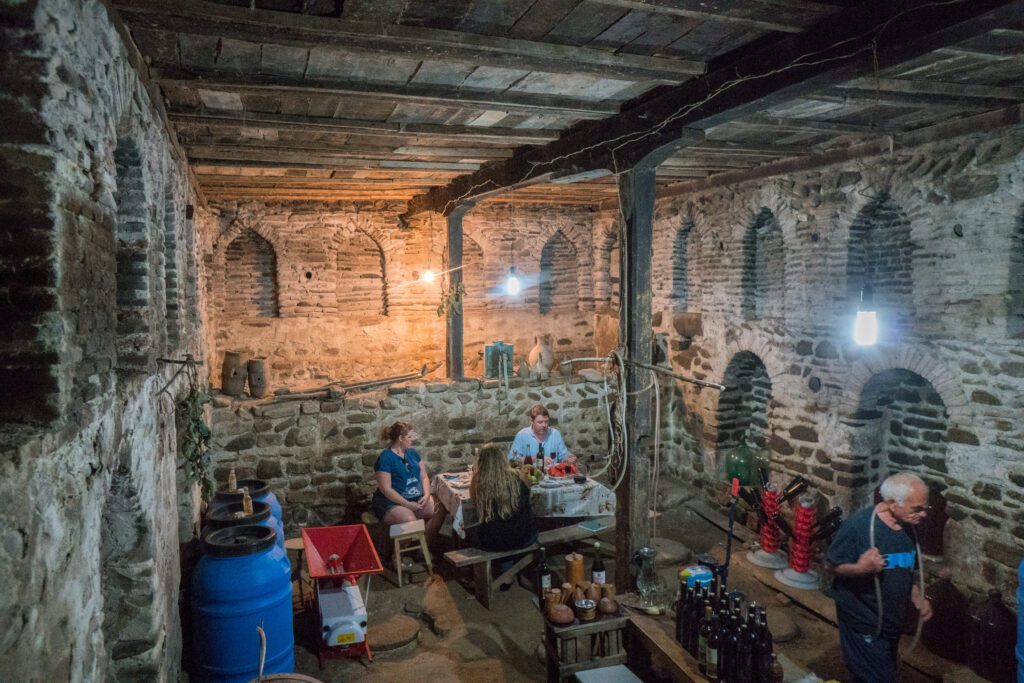
Kartli is the heartland of Georgia.
The wine region stretches from the northern city limits of Tbilisi, westwards past Gori (Stalin’s birthplace).
The infrastructure is less developed, but this can actually help you feel more authenticity as you visit small family producers, off the regular tourist trail.
The proximity to Tbilisi means you can be standing in a vineyard within less than 10 minutes of leaving Tbilisi. You’ll also find historic sites like Jvari Monastery (UNESCO) and Uplistsikhe bronze age cave town.
Best Georgian Wines / Grapes From Kartli & Mtskheta
Here you will find lighter white wines than Kakheti, mostly aged in qvevri with skin contact, but the grapes and the style don’t lead to the very bold, tannic wines you find in Kakheti.
- Chinnuri (also called Chinebuli) – Light, aromatic, and high acid-producing fresh and easy drinking / simple wines. Expect quince and lemon.
- Goruli Mtsvane – A cousin to Kakhuri Mtsvane. Lemon and lime, green apple.
- Tavkveri – Strawberry, red plum, earthy notes.
- Shavkaptio – Still a rare grape. A deeper red wine, typically with a much fuller body than tavkveri. Fresh minerals and dark berries.
The Ateni microzone, near Gori, is the only sparkling wine-focused microzone in Georgia, currently. Though it is still under development, and there are few good examples of those wines, places like Chateau Ateni and Ori Marani are leading the way.
Wine Tours From Kutaisi (or Batumi)
Kutaisi is the capital of the Imereti region of West Georgia. Kutaisi airport is the second largest in Georgia and mainly serves flights from European cities, primarily via Wizz Air. This makes it a common entry point for tourism.
The wine regions we discussed above are all in central and east Georgia. The below options are all in West Georgia and hence 3+ hours from Tbilisi, which makes a visit in a single day impractical. But visiting from Kutaisi or Batumi, in some cases, is the best option, or taking a multi-day tour from Tbilisi that explores a greater area of Georgia as a whole.
Where to Stay in Kutaisi
- Best Western – 4 star, very central in Kutaisi. At White Bridge. Options in Kutaisi are limited, this chain hotel is currently the best standard on offer.
- Newport Hotel Kutaisi – ~4 star. Typical, central.
- Grand Opera Hotel – 4 star. International style central hotel.
- Sanapiro Hotel – 2 to 3 star. Simple, standard hotel by the river just south of the city center.
Imereti Wine Tours / Areas – Kutaisi
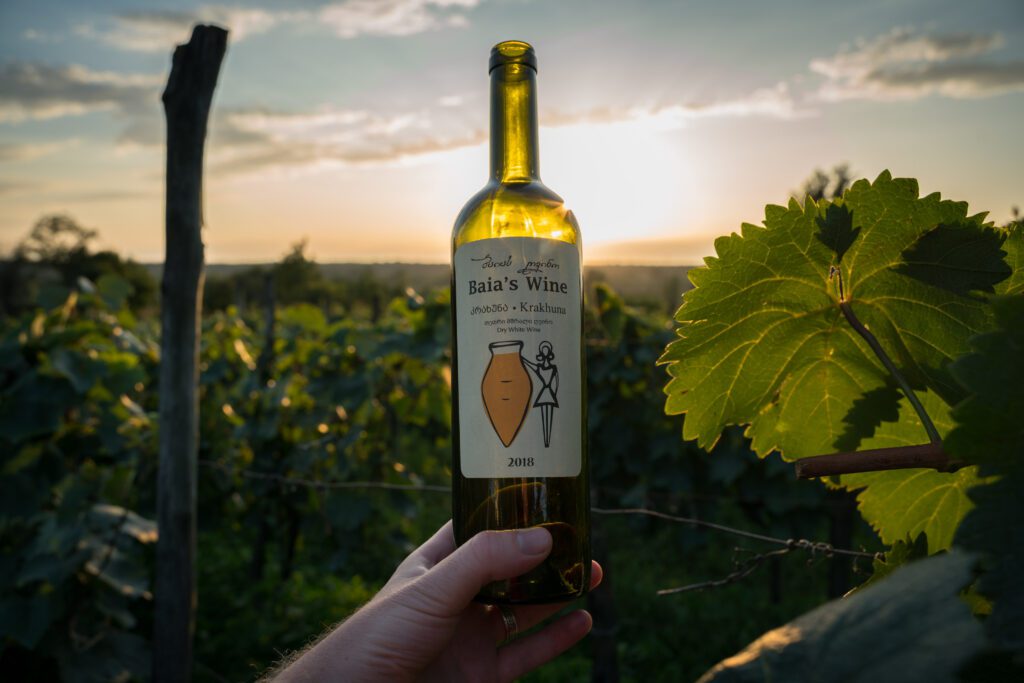
Imereti is Georgia’s second-largest wine region. It’s famed for higher acid white/amber wines and lower tannins than Kakhetian wines. Here, instead of bold and dark amber wines, you’ll often find light straw and golden wines. This is partly because less skin contact is typically used. Sometimes 30% of skins or less, rather than 100% (which is common in Kakheti) will be added.
Though grapes are grown across much of the region, the primary growing area is about 1-hour southeast of Kutaisi. Some of the main settlements within the growing area are Bagdati, Obcha, Sviri (a PDO microzone), Zestafoni, and Terjola.
Best Georgian Wines / Grapes From Imereti
- Tsolikouri (White) – West Georgia’s most prolific grape. High acid. Pear, melon, minerals, floral notes and often honey.
- Tsitska (White) – Quince, melon and pear. Sometimes wildflowers and honey.
- Krakhuna (White) – Tropical and stone fruit flavors which can bring additional complexity to the other white grapes above in a blend.
- Dzelshavi (Red) – Lighter red that when used as a single varietal is normally much closer to a rosé.
- Otskhanuri Sapere (Red) – Blackberry and smoke, along with other dark fruits and licorice.
A blend of the three white grapes above is sometimes called the Gelati blend. Any of these three grapes can be used to make the PDO wines in Sviri.
Georgia’s most famous female winemaker, Baia Abuladze, along with her sister Gvantsa and brother Giorgi, are based at Baia’s wines in the village of Obcha. Their fast-expanding operation still retains a family feel, though the winemakers themselves are not always available to host in person – so make reservations early if you want to try and meet them.
Baia’s success inspired a lot of other local winemakers to up their game and welcome tourists as well as focus on higher quality wines for export.
Racha & Lechkhumi, Georgia Wine Tours

Racha is considered by many Georgians as one of the most beautiful places to travel, especially when the autumn colors arrive.
The sheltered valley in lower Racha, backed by the Caucasus mountains to the north, runs east from Oni, all the way to the border of Lechkhumi region and the Tvishi (appellation).
The town of Ambrolauri is the best location to base yourself to explore the wine region.
Georgia’s first PDO wine, Kvanchkara, a semi-sweet red wine brand that was invented during soviet times to appeal to the Russian market, comes from lower Racha.
In addition to Tvishi, on the Rioni river, more wineries of Lechkhumi are in the next river valley to the west. The most famous but also very rare wine, Usakhelouri, comes only from the small villages around Okureshi (PDO).
Though these 3 most famous wines are typically sweet or semi-sweet, Racha’s production of dry wines has increased significantly of late as winemakers diversify. If you are not into sweet wines, there is still a lot to explore on a wine tour to Racha.
Learn more about Racha and the wines of the region in our wine regions of Georgia guide.
Most tours to Racha are focused in eco-tourism. Wine is barely on the agenda unless you go to a specialist food & wine tour company.
Where to Stay in Racha
A day trip to Racha from Kutaisi is certainly possible but an overnight in Ambrolauri will allow for a much better exploration to Tvishi as well. If coming from Tbilisi, it’s a must.
Accommodation near Ambrolauri is limited and there is not much above 2 star standard.
- Hotel Karse – Acceptable 2 star budget hotel alongside Naberauli winery (commercial wines, not thrilling but ok)
- Chateau Dio – Family Wine Guesthouse with budget rooms and typical homemade wines.
- See all options in near Ambrolauri
Other Georgian Wine Regions

The remaining wine regions all offer something very off the tourist trail for any avid wine explorer. Lacking in wine tourism infrastructure, independent exploration is more of a challenge, and finding high-quality artisan wines is limited to just a handful of the best producers. In summary, the wine industry of these regions is fledgling.
- Bolnisi (& Asureti). Just over 1 hour south of Tbilisi. Bolnisi (PDO) was originally a German (Swabian) settlement, established in 1818 by colonists. The valley is famous for its ancient archeology, where the oldest remains (1.8m years) of hominid life in Europe have been discovered. This is probably the most underrated wine region in Georgia. Amazing wines to rival Kakheti, but on a much smaller scale. Nearby Asureti, also a former German settlement, also just got PDO status. I lead wine explorer tours here quite often.
- Meskheti Region. South west of Borjomi, about 3 hours drive from Tbilisi. The region is famed for high altitude wine (900 to 1,700+ meter) and wine terraces which have recently begun to be refurbished. Research Natenadze’s wines or visit his restaurant “Tabla” in Akhaltsikhe.
- Samagrelo. 1 hour west of Kutaisi. Subtropical climate leads to more focus on red wines, typically lighter-bodied reds. The area around Martvili Canyon (a now very touristy complex) has the highest concentration of artisan wineries. Visit Oda Winery, the original natural wine pioneer of the area.
- Guria. South of Samagrelo, a little over an hour from Kutaisi, or from Batumi which is on the other side of the region. A few independent wineries close to Ozgureti are leading the initial resurgence of Gurian wine, which has been absent since the 19th century – as the Soviets focused on tea plantations in this region, rather than wine. Menabde Winery – Rustic, well-presented artisan wine guest house near Ozurgeti.
- Adjara. The winemaking scene, like Guria, is quite undeveloped. There are a few wineries dotted inland from the Black Sea as you head North along the coastline from Batumi. The most interesting wine area though, is the river valleys directly east of Batumi, which wind inland up into the mountains. Chateau Iveri – 3 Star wine hotel in the mountain valley east of Batumi is making excellent traditional food and interesting wines (which still need more work).
- Abkhazia. Currently occupied by Russia and not a region we’d recommend going to right now.
Wine Tasting Georgia
Are you ready? Drop any notions of what you think a wine tasting is. Georgian wine tasting is no sip-spit-leave experience, it’s an event.
IN SUMMARY: Artisan wine tasting in Georgia is an event. This is no sip-spit-buy-leave affair. If you want a typical international tasting, go to shops or wine factories. If you want amazing Georgian hospitality, seek out the best artisan winemakers and visit them at their home maranis (wine cellars).
The Georgian Wine Tasting Experience
If you are looking to replicate a professional Californian wine tasting in Georgia, forget it. And it turns out, in many instances, that’s a good thing.
This is not to say that the typical production-line cellar door visitor experiences don’t exist, in fact, some of the larger commercial factories and wine shops are definitely trying to emulate that style. But those sanitized tastings are a huge step away from Georgian wine culture – a sign of globalization and profit focus, over tradition.
Professional sommeliers and wine exporters need those conditions in place to be objective, and they can still be respected even at the smallest family wineries, when required. But for wine tourism, the real Georgian wine tasting experience is what you should seek out. If you don’t, you’ve really missed out.
What to expect at a real traditional Georgian wine tasting:
Ie. A proper artisan tasting with the winemaker, not a factory cellar door.
- You’ll need more than 1 hour to taste 3 to 4 wines. 1.5 hours is a better amount of time, if not dining – and there will still be food, even if not dining.
- Why? There are a bunch of reasons.
- Each wine tasting pour is likely to be 100ml+ This is no sip of wine. You’ll get most of a glass. If you finish it quickly, the host may pour more before moving on.
- You think you are getting a 3 wine tasting, but if you show enthusiasm for the wine, aside from refills, you will often have the host bringing out extra wines to try. Or even fresh wine from the tank or qvevri (occasionally, don’t expect that, it’s seasonal too).
- There is always chacha (Georgian grappa). Whether you like it or not! And then, the liqueurs or brandy appear too.
- There is always food. At a minimum bread and cheese, but typically a cornucopia of traditional snacks will appear.
- The winemaker is often there with you to explain the wines in detail. You will have lots of questions, they will have a passion to share. These conversations add to the time to taste.
- Good wine tastings are never free. If a free wine tasting is on offer, it’s normally a factory or shop trying to sell you wine – and often the tasting is the cheap stuff. Real hospitality is about the wine tasting experience, not selling the wine. For that, as a tourist, you have to pay.
- Finally, a spittoon is rarely present (unless you request it). And hosts are enthusiastic to have you enjoy their wines. It feels impolite to pour away or leave wine, so pacing yourself and snacking is needed.
If most or all of the above elements are lacking when you come to do an artisan wine tasting in Georgia, you went to the wrong places. Read the rest of this guide to find out how to fix that issue ;-)
Country Wine vs. Factory Wine vs. Artisan Wine

IN SUMMARY: Not all artisan wine was born equal. Though home winemaker experiences are the most memorable, the wine consistency is unpredictable and you really need to visit the right people to avoid drinking faulty and funky wines. Some factory wines are great, and should be tasted, but don’t only do factories as you’ll miss the real Georgian hospitality.
Aside from variations in the wine tasting experience, as detailed above, there are also categories of the type of wine you can expect to taste and how that differs from place to place. Whether visiting a large commercial producer or a micro-producing artisan.
By type of wine, I do not mean varietals. I’m referring to the type of production, and the success of that production. One negative of the Georgian wine market, for all its provenance, is the inconsistency.
Not every artisan is an expert – some have no formal training beyond seeing their parents make wine. Not every qvevri wine survives faults and errors. And even those that do may not be wines of note.
When I consider Georgian wine, I use some different naming conventions to differentiate the types of wine from this perspective. Once you taste a variety of wines across Georgia, you’ll understand them more.
- Bad Wine – faulty wine where the faults are present enough to make the wine generally unenjoyable. It is not to say you won’t find some intriguing qualities in the wine but it is not wine you’ll be buying to take home. Using the term “natural wine” to justify overly faulty wines is simply disappointing but I’ve even seen quite famous producers do it, rather than use their bad batches to make vinegar.
- Country Wine (Home Wines) – these are wines that are simple, lack complexity, and/or have mild faults that don’t destroy the enjoyment of the wine but are certainly not improving it. Anything from watery table wine to poorly made but acceptable homemade wines that are a little “funky”. Residual yeast and other qualities remind us of the “natural” form of the wine, which has not yet reached a level for it to be bottled and exported. But, with good hospitality and good food, these wines can form part of the whole and many good memories – until the chacha wipes them clean, that is.
- Artisan Wine (500 to 50k bottles per year, total) – Small batch, specialist production that has reached the point of quality, free from errors, and which expresses the character of the region and the grape. Essentially, home winemakers and small enterprises who really know what they are doing. Every winemaker has a story and the story behind the bottle often adds to the enjoyment of the wine as well, something that commercial wines rarely offer.
- Commercial Wine – there is a range to commercial wine. I’d break this into Independent Commercial (50k to 250k bottles per year) and Mass Market Commercial (250k+ bottles per year). With the former, you may find quality throughout the range, or a mix. With the latter, they typically have boring, low price wines and then a premium range. But it depends!
What you can expect is consistency and freedom from errors. The free or very cheap wine tastings at larger factories normally feature boring wines. You might just as well buy a $5 bottle of Merlot and save the time coming to Georgia. If those are the only tastings you do, you will not real discover anything about Georgian wines. Of course, some factories offer above average wines and commercial producers can also make very good wines… - Fine Wine – Wines that are perfectly balanced, expressive, and complex. Wines that lift your very soul and tantalize every inch of your palate. Whether produced in small batches by an artisan, or at a large commercial wine factory, Georgia has some incredible wines to offer.
Budget wine tours normally feature cheaper commercial and country wines only. Ie. the least interesting wines and the cheapest tastings. They are typically designed by tour operators, not wine experts, and ultimately, you get what you pay for – a 100 GEL ($40) wine tour won’t have you tasting expressive wines.
Higher-end tours are developed by wine experts for wine lovers with a focus on discovering a range of wines across terroirs. A 100% fine-wine focus can make any tour completely unaffordable for regular wine tourists, but the balance of artisan, fine wine, and some better commercial wines can provide variety, quality, and a tour price that isn’t out of bounds for the typical wine tourist.
Typical Wine Tasting vs Supra (Feast) vs Home Artisan Wineries vs Shops vs Factories
In Summary: Attending a supra or visiting an artisan winemaker in their home winery for a tasting is by far the superior experience. Combining the two is even better!
Wine tasting is prolific across Georgia. From the government campaign to hand out free bottles of wine to tourists at passport control (yes, this really happens, periodically). To walking a residential street in Tbilisi and some old Georgian guy asking if you want to come down in his basement for some wine. Not a wine shop, not a professional wine cellar, literally just a basement in a residential courtyard where he stores his wine. I can confirm the wines, sadly were average, but this was not a scam or kidnapping attempt.
As someone who has attended hundreds of wine tastings, and feasts (supras) too (including random and spontaneous ones), as you may imagine, quality can vary. If it’s your first time in Georgia, it’s easy enough to end up leaving the country having tried some “funky” wines and maybe have a “supra” that is little more than a budget dining experience with a couple of toasts.
And, because Georgia is still quite unknown to western tourists, and because people here are typically really friendly and enthusiastic about hosting guests (its part of the culture) then even the below-average experience (by my standards, as someone who does this all the time) may still be both fun and memorable.
But once you’ve quaffed expertly perfect artisan qvevri wines and dined in the most exuberant fashion, you will realize what you were missing.
It’s not just about finding the best of those experiences, it’s also about finding an authentic version, period.
Where to do Wine Tasting
The tasting experience differs significantly.
Wine Shops / Bars

Tbilisi (and Kutaisi/Batumi) are now littered with wine shops that are part bar, part tasting room, part shop. There are a variety of hybrids. Ultimately, it’s a place where you can go to taste wines, buy wines and, with the good ones, encounter someone who can give you a little background on what you are tasting.
In the best scenario, an expert will guide you through a variety of high-quality wines from around Georgia. In the worst scenario, a teenage shop assistant with no idea about wine will serve you a few tastes of a $4 a bottle, mass-produced wine, and then pressure you into buying some.
The solution, of course, is not to just walk into one of the touristy wine shops in the middle of the old town, due to a “free wine tasting” sign outside. Instead, look up some high-quality wine bars and visit those.
Pros
- Cheap or free wine tasting.
- Most places accept walk-ins, though some may need a reservation.
- Easy to get to in city centers.
- Explore wines from around Georgia, all in one place. Large selection.
Cons
- Busy/popular shops can’t normally offer much personal attention.
- The shop staff are rarely sommeliers or winemakers (though most of the good shops will have at least 1 expert, they can be quite busy).
- More of a brief introduction than an experience, in most cases.
More about wine bars and wine tasting in Tbilisi.
Recommendations in Tbilisi:
Factory Cellar Doors
As I mentioned above, there is nothing inherently wrong with large wine corporations. Some are making excellent premium wines and hygiene standards as well as other best practices typically mean even their budget wines meet a minimum standard.
Some also have lovely and professional wine rooms. It’s certainly worth exploring both larger companies, and smaller artisan/bio wineries, depending on what you are searching for and how much time you have.
Pros
- Cheap or free wine tasting
- Consistent minimum wine standards
- Most places accept walk-ins, though some may need a reservation.
- Some of the larger companies, like KTW, Chateau Mukhrani and Badagoni have wine rooms in Tbilisi.
Cons
- Mostly mass-market wines you can get in the supermarket in Georgia. The VIP or premium range may have to be requested specially.
- Typically hosted by novice staff, not all cellar doors have sommelier-level experts on hand.
- Often lacking soul – something you’ll only become acutely aware of once you have experienced real Georgian hospitality.
- In some cases, feeling like a cog in the tourism machine. If you end up on a tour that stops at KTW Patardzeuli or Khareba Kvareli (like most of the budget tours do), you’ll realize, once it’s too late, what you walked into. That said, the wine tunnel at Khareba is cool, even if the big bus tours parked up outside are not.
Recommendations:
- Askaneli Brothers. Some of the best mass-market wines, the premium ranges are typically excellent. Wines produced on-site but it’s quite a way out of town. Taxis can be booked easily though.
- Chateau Mukhrani Wine Bar. In the heart of old town Tbilisi. They are a sort of cross-over between quality production and the mass market, having wines of various classes with some excellent wines. The location is too touristy for my preference, but it’s certainly very convenient! This is a wine room only, the actual chateau is about 45 minutes from Tbilisi.
- Shumi (Near Telavi, Kakheti). Well set up for tourists (ie. touristy but not unpleasantly so). Their Iberuli wines are mid-priced and have some good quality in that range. They have a museum, factory with qvevris and steel tanks, and a restaurant / cooking classes. Consistent mass market wines (2.5 million bottles per year)
Home Artisan Wineries
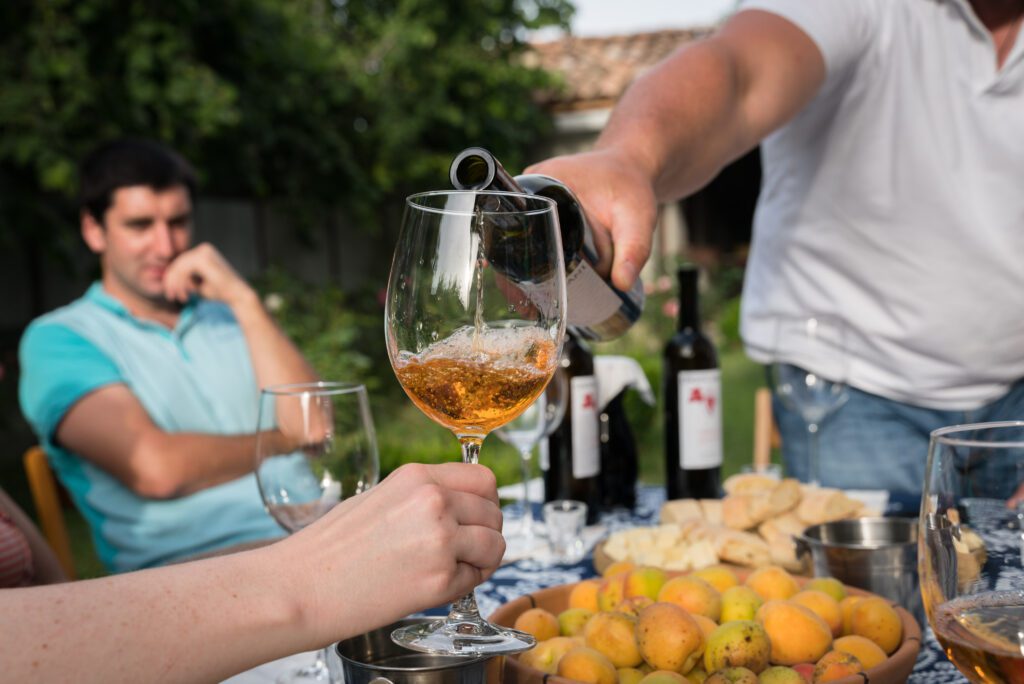
As I mentioned above, there is a wide range of wines from very homemade to artisan in Georgia. Some home wineries may offer the tastiest and most unique homemade food, and very enthusiastic hospitality while serving barely passable wines. Or, great wines and miserable hospitality (this is rarer but I’ve certainly encountered it).
Finding the trifecta of amazing wine, food, and hospitality is actually pretty hard. If you want your host to speak fluent English too, then you are really cutting down your options, so going with a translator or guide is often required. More info on amazing supra vs. passable supra, is below.
For wine tastings, though, where wine is the priority over the other factors, visiting an artisan winery is a must. The whole Georgian winemaking tradition was historically family-based and made small-batch and mainly organic. To substitute this type of tasting with factory wines would miss the point of coming to Georgia.
You can easily visit wine factories across the world. But to sit down with a winemaker whose family has made wine for generations, and taste a small-batch wine they made, right there in their cellar, in the country that invented winemaking… That’s why you are here, right?
Pros
- It’s an unmissable experience within Georgian culture and the history of wine as a whole.
- Taste rare, small-batch wines and visit the cellar where they were made.
- Meet the winemaker, rather than a member of staff.
Cons
- Normally more expensive than the other options, and never free of charge.
- Often no English is spoken.
- There are so many wineries, and levels of quality, it’s hard to know who to visit.
- You can’t self-drive to the middle of wine country and then taste a bunch of wines!
Recommendations:
- Take a premium wine tour.
- Read our list of wineries for some ideas if you want to visit independently.
Restaurants & Pairing Menus
Back in 2016, restaurant wine lists normally focused on the same few large corporations for premium wine, and then the rest was jug wine (draft wine). It was pretty lame. Today, there are an increasing number of restaurants with Georgian cuisine and interesting wine lists representing a mix of artisan producers and better wines from larger producers.
However, as far as multi-course wine pairing menus go, these barely exist. I’ve don a few special wine pairing event meals but am yet to find a restaurant offering a properly thought out pairing menu as part of their regular daily offering in Tbilisi. Typically, the best you can expect is to have some wine suggestions for what to drink with the food you ordered, with mixed results.
That said, I’ve been working closely with the sommelier and chef at a fantastic vineyard restaurant in Kakheti, and in April 2023 they launched their tasting menu, which is included on this tour.
Recommendations:
- Barberastan – Unique historic Georgia cuisine. Casual fine dining with prices to match.
- Otsy – A fusion of Georgian and international.
- St Bunny – Wine bar restaurant. Extensive wine selection and creative takes on Georgian cuisine.
- Culinarium Khasheria – Modern Georgian. Small but expert wine list.
- Z10 – Modern Georgian.
- Georgian House – Great traditional food, atmosphere, and service. The wine list is sadly lacking.
There are many more than this, I hope to release a list in the future!
Amazing Supra vs Passable Supra
IN SUMMARY: An amazing supra has an eloquent, dynamic tamada (toastmaster) who reads the room and makes the event interactive. Diverse and delicious food, high quality wine (not basic bulk wine), polyphonic singing, and dancing. A passable supra lacks some or most of these elements.
The supra is one of Georgia’s most quintessential (and glorious!) experiences. A rollercoaster of food, wine, history, culture and emotions. I’ve laughed heartily, cried, and shared heartfelt stories (of the host, guests and of my own) that you’d never expect a stiff-upper-lipped Englishman to say out loud.
The supra is about human connection as much as the wine and food. Though any gathering where friends share food, wine, and toasts can be called a supra, the best ones include the best of everything and leave you feeling like you really experienced life, on a level you were not expecting.
We have written more extensively about the supra here.
But, from someone who has traveled across Georgia, experiencing many standards of supra, let me explain the difference between a passable one (which is still worth it, if you can’t do better) and a life-changing one.
The Tamada (Toastmaster)
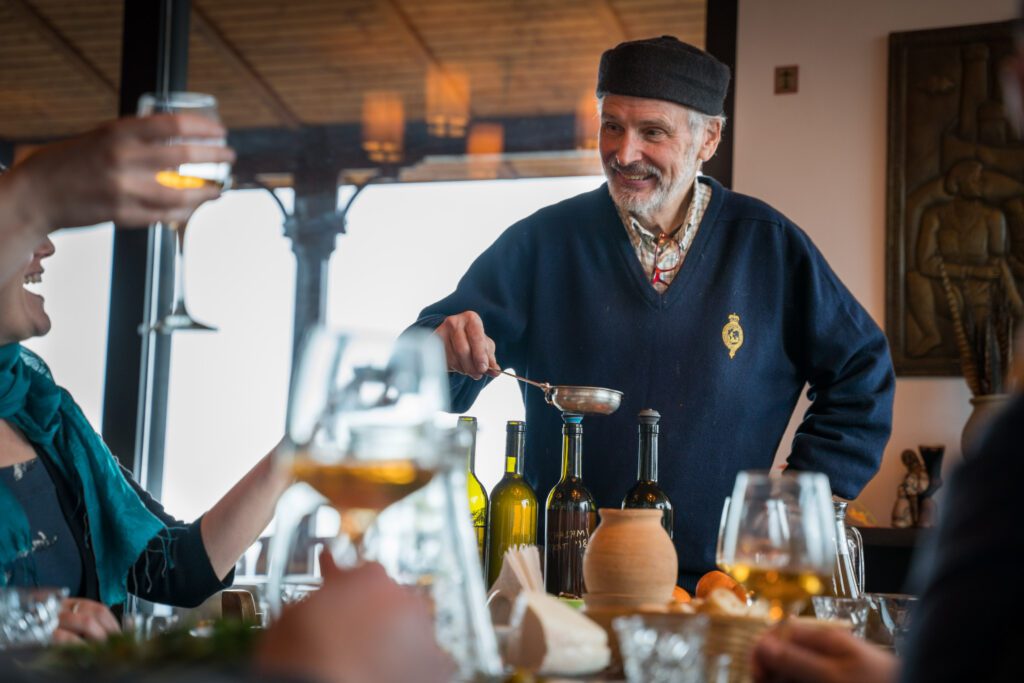
The tamada is the lynchpin of the Supra. They guide the event. They lead the toasts. They work the room. A great tamada is truly masterful at social dynamics.
- A great tamada brings life to every toast. They are eloquent, even poetic in their mastery of the topics they present. They weave surprising stories on every theme of the supra.
- A great tamada leads other guests to contribute, rather than hogging the limelight for themselves. They connect all the guests together.
- A great tamada reads the room and guides the topics of the toasts in waves along with the mood.
- A great tamada compels attention and touches on every emotion over the course of the supra.
- A great tamada drinks to every toast but does not ever act inebriated.
A poor tamada fails at most or all of these elements and simply makes basic toasts “to peace”, “to love” without providing depth or real connectivity. The language barrier can make it difficult for foreigners to experience all of the above, so finding an excellent English-speaking tamada, or having a great translator/guide with you is essential. Though eloquence may be lost in translation, a masterful tamada can perform all the other skills above, even with more basic English.
The Food & Wine
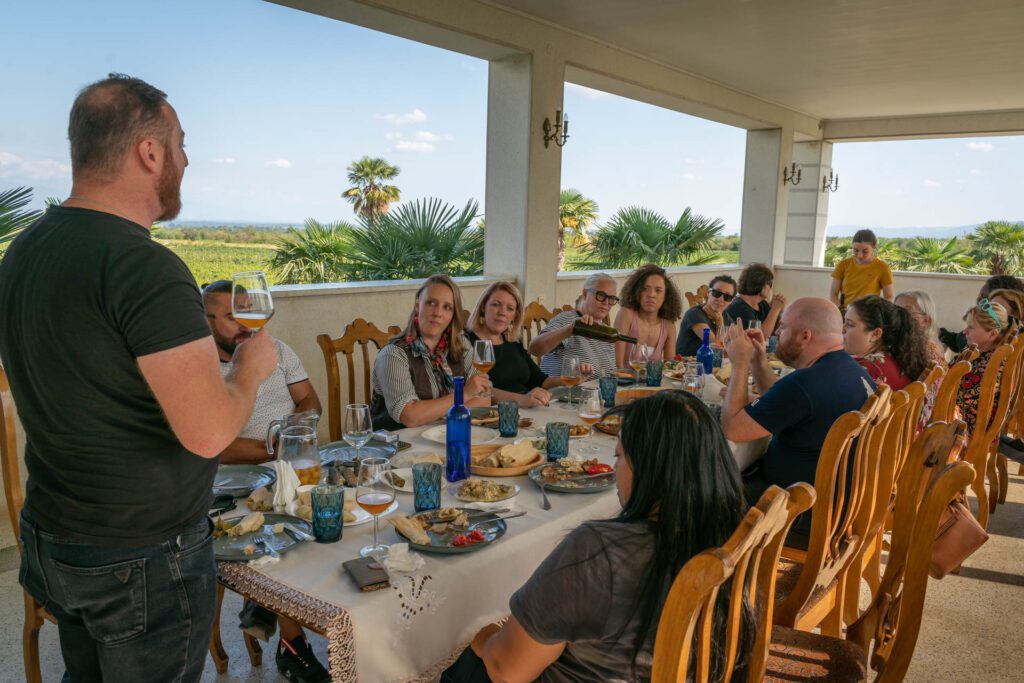
The food should be traditional, though really the rules can be broken. Either way, a better supra has better food and better wine. The typical countryside supra may include basic budget dishes like khachapuri, khinkali, mtsvadi (pork skewers), and salad. Stacked high on the table. Served with rough and ready “khakhuri” wine, the typical lower-end Rkatsiteli, made to varying standards.
A next-level supra will feature an abundance of additional dishes, more premium options, more refined versions, and better presentation (in some instances). Artisan wine, by the bottle, or direct from the artisan’s cellar in jugs, and made to a higher standard. Not surprisingly, this all costs more.
Though my preference is a tamada who is also a winemaker and who can provide the supra experience along with their own wines, and preferably elevated food made by their family, you could also enjoy a great supra, as many Georgians do, at a restaurant, with a private table and a tamada.
Finding this experience is much rarer than you’d think, as being a tamada is considered an honor, rather than a paid position. When I first arrived in Georgia I tried to “hire a tamada” and got laughed out of most Facebook groups by Georgians. I was told you had to “be invited” to a supra or visit a family at their home.
Though tour guides can and do perform the position of tamada on tours, it is still the case that most restaurants (I don’t know of any, currently) do not offer a tamada service. And, for every story of a foreigner getting invited to a supra just after arriving in Georgia, there are hundreds of disappointed foreigners who leave never getting to experience a sensational supra, or any supra. You just don’t hear those stories of not getting invited, it’s not much of a story compared to the lucky few who did.
What to achieve with the food & wine:
- Elevated food: more selection, better quality, and piled high on the table.
- Artisan wine, not just basic homemade style.
- Dine with a family or tour guide.
And More…

Then you have the bonus items that make the supra even more special.
- Traditional polyphonic singing. At its most authentic when the tamada and other Georgian guests perform at the table. A worthy substitute is having a singing troupe perform.
- Traditional Georgian dancing. Again, having hosts that dance and will perform or even teach you a few dances, is the best. There is a winemaker who is a former national dancer and now a dance teacher on this tour (make sure to confirm in your booking that you want the dance experience). Hiring a dance troupe is also great.
- Help prepare the feast. Helping out with making khinkali or other dishes gives you an even stronger connection to the dining experience.
- The right number of guests. Less than 4 + tamada and it’s unlikely the event will buzz. More than 18 guests and things become impersonal and disjointed. 8 to 14 is the sweet spot, in my opinion.
If you have limited time in Georgia, getting invited to a supra by luck is very unlikely (I spent more than 2 months in Georgia before getting invited to a supra). If you book a full dinner at a family winery, you are very likely to experience some sort of supra. But this could be the most basic version, it depends on what you pay and where you go.
No matter what you choose, you should make attending a supra a priority as even the below-average ones are normally fun – though I’ve also had some plain awkward/weird supras!
The Supra – Tour
This is not “a” supra. This is “the” supra. Combining all the best elements of supra into one perfect event. Amazing traditional food, artisan wine, a tamada who is also a winemaker, polyphonic singing table side. Join this Georgian cultural journey and become a part of the living tradition of supra.
Learn More About Joining The Supra Tour.
When To Visit Georgia And Take A Wine Tour
Every season has something to offer for the wine traveler. It really just depends on what you prefer! Below, are some explanations of each season, and the related activities and pros/cons.
- Late August To Early November – Harvest Season. Most of the harvesting occurs between 5th September and 20th October – this is when it is much easier to attend Rtveli. Kakheti being the first to harvest, typically, starting even in late August, and Racha often being the last to harvest all the way into mid-November.
The weather is also typically dry most days and less hot than in the summer season. It’s a great time of year! - November To March – Off-Peak Wine Maturation Season. Slower pace, fewer tourists, winemakers are free to host you without distraction. But there are less tourists, and hence less tours and some places don’t host at all. The weather can be intermittent. Accommodation prices are lower. In some cases, on more specialist tours, you can also get to taste the juvenile wines, direct from the qvevri.
- April / May / Early June – New Wine Season. Qvevris are being opened countrywide as winemakers prepare to bottle the last harvest. There are a lot of wine festivals happening during this time so it’s a great time to taste many wines easily in one day, in one location. It’s normally a busy time for wine tours, especially May and June when the weather is normally dry but not too hot.
- June / July / August – Summer Peak Mass-Tourist Season. Tbilisi’s old town becomes a hive of activity. Tours and tourists are rampant. It’s busy. The weather gets hot, especially in Tbilisi. Temperatures of 35 to 40 celsius are not uncommon in Late July and August. Kakheti is cooler.
How To Visit / Transport To Georgian Wine Regions
A line up of the options.
Georgian Wine Tour – Guided Tour Groups

A full outline of the types and price points of wine tours in Georgia is in the next section below.
The major reasons to take a tour are numerous:
- Expert guide, learn a lot as you travel.
- Good level of English (normally!) – and hence translation, as many winemakers, etc. do not speak English.
- Share the experience with other like-minded people. Small or larger groups.
- If traveling solo or as a couple, it often works out cheaper than trying to do the same experiences independently.
- A fast and efficient way to get the most out of your time – do a lot each day without any messing about, getting lost, or other issues – as long as you take a good tour, of course.
- If taking a premium specialist tour, discover more off-track and unique wineries that are harder to find independently.
- A specialized custom tour can be designed by experts in the region better than you could figure out yourself based solely on internet research.
- All-inclusive options – no need to be fiddling with cash after too many glasses of chacha.
- Get home safe with a sober driver!
Find more details on all this below.
Private Driver Hire – Self Guided Wine Tour in Georgia
Hiring a driver with a vehicle can often work out only a little bit more expensive than self-drive and is, of course, much safer. If you are keen to plan your own trip, make bookings with wineries yourself etc.
Just to note a few things about this:
- You need to pay a day rate and fuel – some drivers bill fixed prices, and some will calculate daily depending on where you go. You also need to cover their accommodation and food – though most will accept budget options.
- Drivers are rarely guides. Driver-guides charge more and are in short supply, they make a lot more in tips taking a group of 7 people than 2 or 3, so are less likely to be interested if you are not traveling as a larger group. But it depends on the season.
- Drivers rarely speak more than rudimentary English. If you want to visit out-of-the-way wineries, don’t expect a full translation service.
- Most drivers use Google maps like the rest of us… They know the places they know and outside of that sphere, once again, they are not guides.
These provisos are just things to consider, hiring a private driver, especially if you already know exactly where you want to go, can be the best option for ultimate flexibility.
But you may also want to consider a private tour over simply a private driver if you want depth of knowledge, translation and local planning expertise.
Self-Drive Georgia Winery Tour
Renting a car is certainly an option. The provision of vehicles is still a bit haphazard, but normally they are well-maintained and issues with insurance rip-offs have been significantly less problematic here than in some other countries. During peak season, availability can be a problem, so book well in advance.
But doing a self-drive wine tour in Georgia could be trouble, for a number of reasons:
- Unless your designated driver has an incredible force of will (see my notes on real Georgian wine tasting above), drunk driving will occur, and the road safety / maintenance is way below average in Georgia already, adding alcohol to the mix is stupid…
- Not to mention, very illegal, as the alcohol limit in Georgia is ZERO. Not 0.05 or 0.08, zero. With the amount of drunk driving in the countryside, they went zero tolerance on this.
- So, a few sips of wine could make you illegal. Even a hangover could. And Telavi as well as the highway back to Tbilisi from Kakheti are two of the main places we’ve seen the most random testing.
If you plan to do a self-drive trip, here are some pointers to do it safely and still have a decent experience:
- Only stop at factory wineries during the day – it’s easier for the designated driver to avoid wines as you will not have the same enthusiastic hosts encouraging you to taste the wine they made themselves.
- Book into a wine hotel or home winery guesthouse for the evening so you can park up and safely enjoy wine tasting in the countryside.
- AND/OR Drive to one of the larger towns, like Telavi, Velistsikhe or Signagi, where they have multiple wineries within walking distance, and then stay overnight. It limits your options quite a lot, but it might be enough if you are on a short trip only looking for a brief intro to Georgian wine country.
Public Transport
Public transport outside of the major cities does exist, but it can be pretty confusing.
Minibuses (marshrutkas) may only have the destination name of a major town listed on the front, and drivers rarely speak English, to travel to anywhere even slightly remote can be a challenge, and once there, getting back is normally even more tricky as passing transport may be infrequent and full already and you may wait a long time. Or you may get lucky, who knows!
If you are on a mega-budget and ready for anything, then why not, locals do it all the time and can be quite helpful to foreigners who seem lost.
The easiest options for public transport are to take a minibus to one of the larger wine region towns, like Telavi, Velistsikhe or Signagi, from Tbilisi, as those are easier to reach without confusion. Then spend the day or stay overnight.
Trying to chain these together in 1 day will be a challenge. But over 2 or 3 days you could at least partially explore all 3, bussing it between each and then back to Tbilisi.
Now the question is, how drunk do you want to be on a packed minibus speeding through poorly maintained country roads? Sick-bags at the ready…
Georgian Wine Tours – Comparison
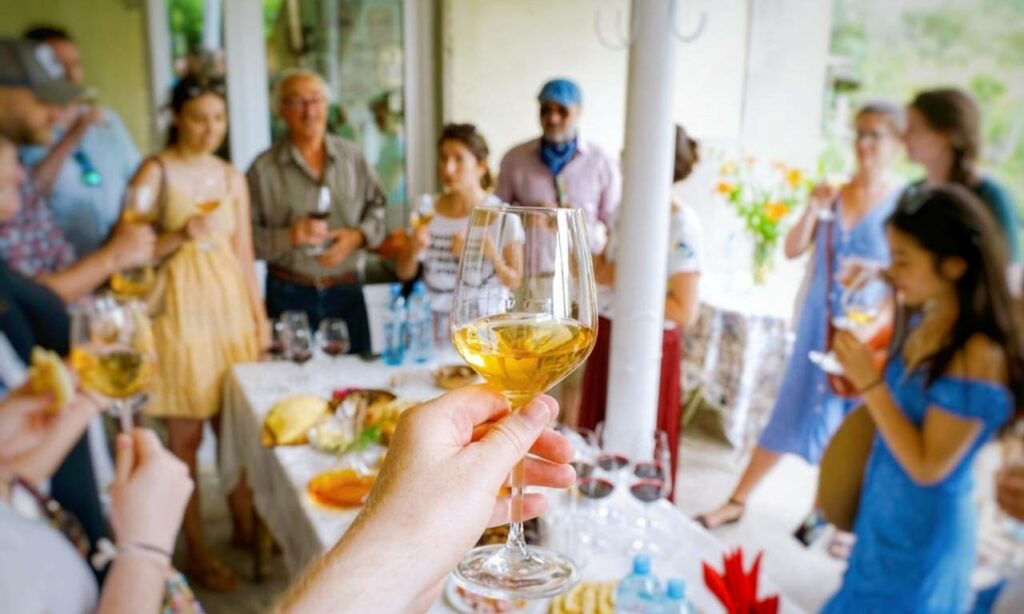
As you’d expect, there are Georgian wine tours for every price range. From the budget-focused mass tourism style options, through a balance of mass tourism and more specialist experiences, up to super indulgent, unique high-end authentic artisan-focused trips.
Which is best? Well, that does depend on your travel style and budget. If you really just want a fun day, see some scenery, save some money, and meet a few people, then budget trips may be all you need.
If you want some authentic depth, off the tourist trail, then don’t be misled into thinking the super budget tours are going to do that.
The issue I find, having spoken to countless visitors here, is that it’s hard to tell which tours are value for money – given that if you just arrived, you probably don’t know how good, or average, the experience is relative to the Georgian market as a whole.
The budget ones seem to include plenty, so why are the premium tours quite a lot more expensive? There are a lot of reasons for this, in this section I’ll show you how to look out for indicators of what you are getting on wine tours in Georgia, so you can decide for yourself what fits best for you and your budget.
I’ll use 1-day tours, priced per person, as the reference but the rules apply equally to multi-day tours. Pricing guidelines below include some of the hidden costs that may not be listed by vendors when you book the tour.
Note: Tipping is not compulsory or expected, but is becoming more common and is recommended. Depending on price of the tour 10 to 50 GEL per person, or about 90 GEL total if you are in a small group private tour, is adequate. Or, whatever you feel!
Budget Georgia Wine Tours – Sold Street-side ($30 to $70 Per Day)
The only types of tours I’d suggest avoiding are the specifically budget wine tours you see advertised walking around old town for about 100 GEL ($40). It’s hard to know exactly what you get with these, without online reviews it’s basically a gamble, but typically you can expect:
- A visit to 1 or 2 large corporate wineries (like KTW, Khareba, Kindzmaruli Corporation). Wine tasting may or may not be included. When it is it will be the cheapest one – at KTW Patardzeuli wine tasting is actually free, and they have been known to pay kickbacks to guides to get them to bring guests).
- Sightseeing
- Lunch at a typical restaurant (budget food, at your own expense). Even budget restaurants are normally decent enough, but we are talking simple, standard cuisine.
- A guide with basic knowledge and medium-level English – but Georgians are great hosts, so normally it’s still fun.
These tours are definitely “just for fun”, not for anyone genuinely interested in Georgian wine, wine culture, artisan wine, specialist cuisine, or an authentic family-style experience. It’s mass tourism, to places that are designed specifically for tourism. Essentially, it’s a bus ticket, a guide, and a fun day out.
Budget Wine Tours in Georgia – Online ($39 to $75 Per Day)
For a similar price, you can go with a company that has lots of 5-star reviews and a clearer expectation set about costs and inclusions. But remember, you get what you pay for. Cheap = mass-tourism spots, lower quality mass-produced wine, larger group, etc.
But what you do normally get is a better quality guide who makes the trip really fun, and, for those who will never dig deeper into the food and wine culture of Georgia, you get an overview of wine country. Always expect to pay extra for lunch and any additional wine beyond the cheap tastings which are (sometimes) included.
How to know you are booking a mass tourism tour:
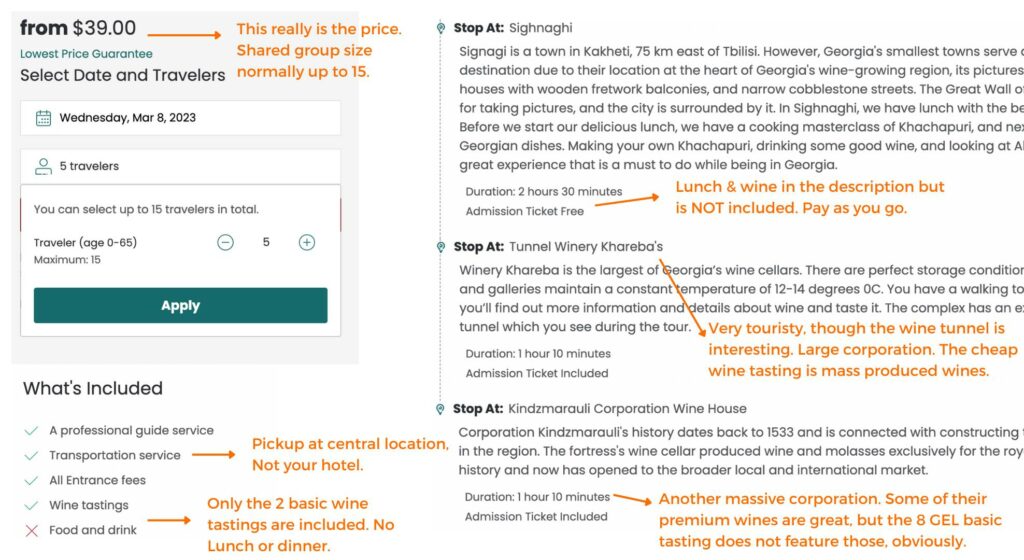
Gamarjoba Tours for Kakheti – This is the most popular budget option, as they hire good guides. You will definitely want to come back to Tbilisi and go taste artisan/bio wines after this trip though, otherwise, you really will have missed out on a real taste of Georgia.
If, like me, food and/or wine is one of the primary reasons you travel anywhere, then wasting your limited time in Georgia on basic cuisine and budget or average wine, is a wasted trip. You already paid for the flights, do you really want to save $50 and miss out? Or do you want to get the real Georgian experience and taste the best and most authentic options?
Not everyone can afford to splurge, I totally get that, I backpacked Asia for a few years on a shoestring, living off street food, and some of it was great! That can be true here too, budget food like Khachapuri and Khinkali are must-try dishes, and very tasty when done well.
But, if you can spend a little more, exploring more unique, next-level cuisine like fried chicken in blackberry sauce, veal kalia, lamb chakapuli etc. will bring you a much deeper understanding of Georgian cuisine.
And, when it comes to wine, super-budget homemade or mass-produced wine vs. complex and expressive artisan bio wine… There is no comparison.
Medium Priced Wine Tours in Georgia ($70 to $150 Per Day)
Next above budget tours, options which may visit some artisan-focused wineries. You may also get a private tour, or a shared tour to keep the price down a bit.
Not all tours in this category were born equal. There is still a lot to look out for to know if what you are getting is just the budget tour but with lunch paid for in advance, or something more specialist.
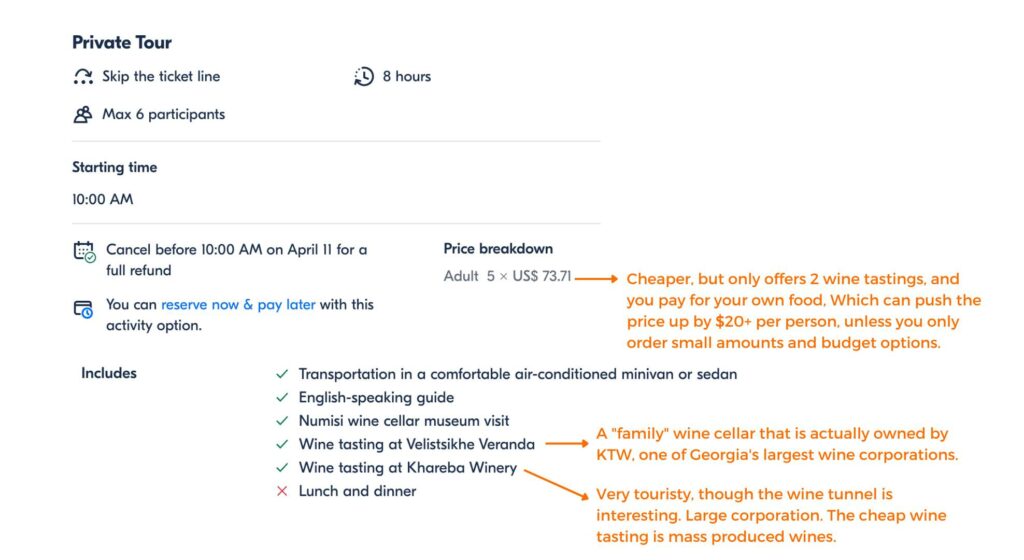
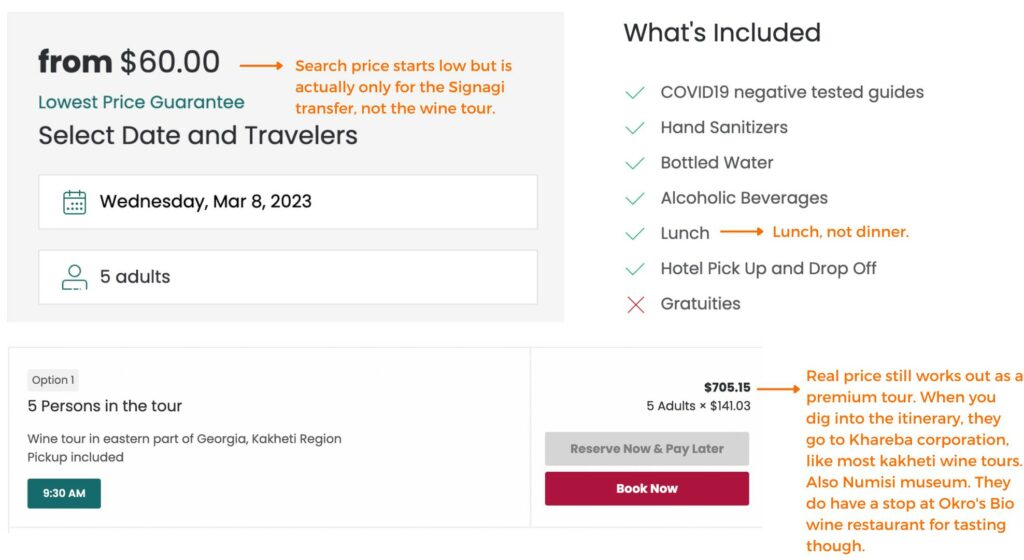
With both of these, you can see for yourself what the extra money is, or isn’t, getting you.
A more personal experience and a smaller group? Yes.
An authentic deep dive into Georgian wine culture? Not quite there yet, but getting better.
Will lunch be at a commercial restaurant or a family home? Each experience is very different, so worth choosing which you prefer, before deciding on a tour. Either can be good!
Hidden costs? You still might be paying for lunch, so the all-in price at the end of the tour may be higher than the list price.
And, always worth remembering that dinner is not included, normally. But, Lunch is typically bulky, even if not high-end quality, or homemade with love, you will normally expect to be full after a hearty Georgian lunch.
Of the options in this category for Kakheti, check out: Traffic Travel
Premium / All-Inclusive Georgian Wine Tours ($140+ Per Day)
The focus of most (not all) premium tours is:
- All-inclusive. Food and wine paid for. No adding up the bill between a bunch of strangers at the end. No hidden costs.
- Focus on small-batch, artisan wineries. Though commercial wineries may also be visited (for balance) but often with tastings of the premium range, rather than the mass-market range.
- Meet the winemaker in person. Sometimes more than one.
- Higher quality food, more variety of food, not just the typical dishes. Often home-cooked food, or visit a boutique restaurant with specialist cuisine.
- Guided by an expert or even a sommelier.
What to look out for in a premium Georgian food & wine tour:
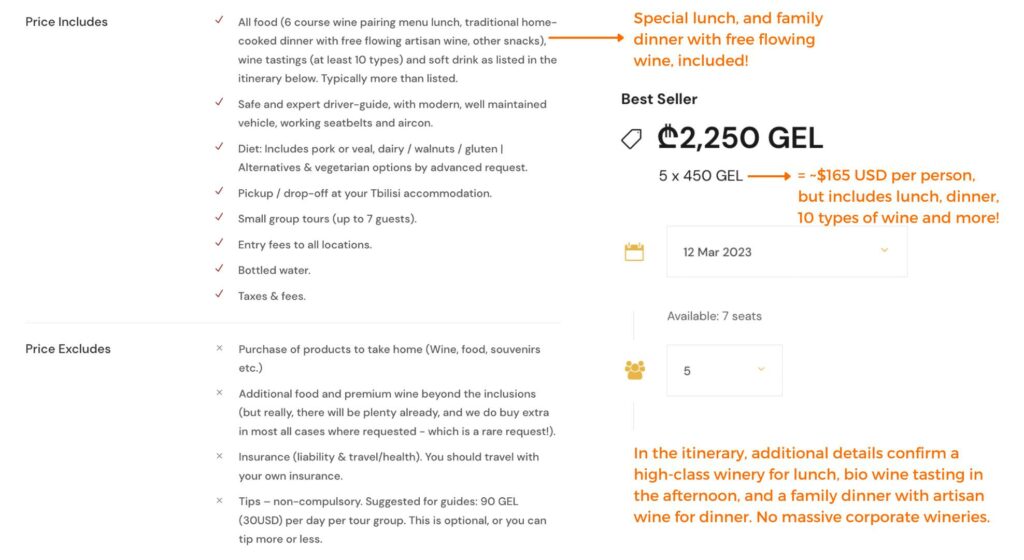
When you are looking at paying $30 or $40 more in order to upgrade to more wines, better wines, a family-style supra/dining experience, and a 6-course wine pairing menu, it becomes a little clearer as to why premium tours can actually be great value for money. It’s indulgent but also guaranteed to tick the authenticity, variety, and quality boxes.
If you don’t want to spend this much, then consider a shorter tour like the ½ day Wine Discovery tour or The Supra tour. To get a similar style experience, but lower price and shorter.
Kakheti is the primary focus with regular scheduled tours during the season. But custom wine tours to Shida Kartli (from Tbilisi) or from Kutaisi to Imereti and Racha can also be booked, and super-specialist trips to off-track areas like Bolnisi, Meskheti.
Freelance Guide / Fully Custom Georgia Winery Tour
Some guides really care about food & wine. But, in my experience, given the tourism market is still in its infancy, the primary focus of most tour companies, and freelance guides, is on sightseeing and attractions. All Georgian guides have a connection to wine, and on a multi day, private, custom tour, you are almost guaranteed to experience some kind of supra (feast).
But, exactly what you get can come down to the individual guide and who they happen to know. Read the section on wine tastings and supra above to understand the difference between what you should be asking for to go next level.
Eat This! Tours offers specialist, fully custom, private, all-inclusive tours.
Or, contact Eat This! Tours to connect you with a freelance food & wine guide. NOTE: In peak season, you should book a few weeks in advance or more.
Rtveli: Georgian Wine Harvest Tours
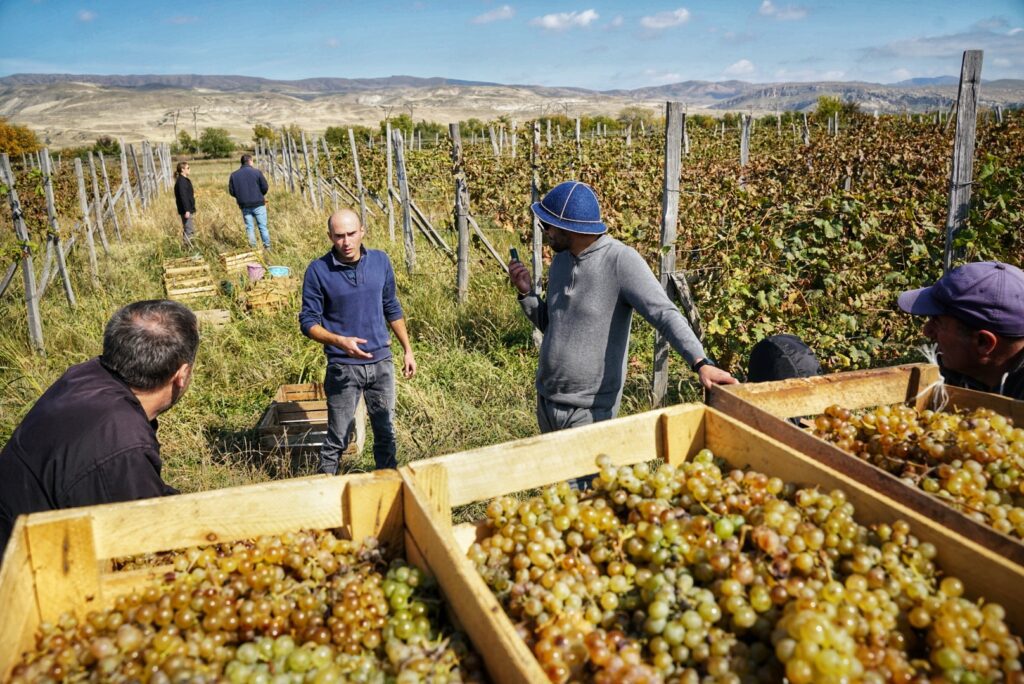
Harvest season runs from late August to November, with the largest amount of harvests (primarily in Kakheti) happening in September and early October.
“Rtveli” is the Georgian name for the harvest festival. This is not a typical harvest festival. Rather than one large celebratory event, Rtveli is the whole process of harvesting and starting the winemaking process, followed by a supra and other celebrations, the key difference though is that every winemaking family, and many others involved in the wine harvest, will have their own Rtveli for their own group. Essentially, thousands of small Rtveli’s happen across Georgia.
The types of wine harvest tours vary, from commercial simulations (where you can go to a big wine factory and simulate activities like picking and crushing grapes) through to tiny family events where you can help a family with their annual harvest, and then have dinner with them.
Their are a lot of traditions and options to experience them, take a look here to learn more about the types of harvest tours you can book, or read this article that discussed the traditions in more detail.
Georgian Wine Crash Course – Download Free Guide
For a crash course in everything you need to know to get familiar with Georgian wines, download our Georgian wine crash course. You’ll also get our wine tasting review card and guide so you can understand how to taste and appreciate Georgian qvevri wines.
Vineyards in Georgia (Kakheti) – Self-Guided Trips
Read our more extensive guide here. A short-list of options below.
3 Kakheti Artisan Family Wineries With Home-Coked Food
3 options who speak English and make good artisan wine and good traditional food. Places that typically produce less than 25,000 bottles per year.
You MUST book in advance in order to get a meal. Wine tasting is sometimes possible without reservation but the winemaker may not be home, or the whole family could be out. You can’t guarantee anything unless you book. Solo travelers may not be accepted or may have to pay a supplement.
Wine tastings normally range from 30 to 120 GEL per person, depending on the amount and type of wines and your group size. To include a meal, expect 80 to 200 GEL per person, including wine, depending on the same criteria as well as the types of dishes (ie. khachapuri and salad is cheap, complex meat dishes are more expensive).
Vellino

In the Iori valley, 1 hour and 20 minutes from Tbilisi, making this an easy stop on the way to Signagi, or a shorter half-day trip from Tbilisi and back.
Beqa (speaks English) has seen incredible growth and expansion on the back of making a diverse range of wines to a professional standard. Their rosé (still a rarity in Georgia from small producers) and saperavi are both excellent, and other wines in the range also express the dynamism of Georgian bio qvevri wines.
Their new wine room is below the vineyard, right opposite the family home. Their success has meant more and more visitors are coming to them, but with this, improved facilities. They still retain a family feel and artisan production, even as they scale up.
Find Vellino on Google maps.
Marani Milorauli
This small home winery is in central Telavi, so you can reach them on foot if you are staying in Telavi (which has ample accommodation options). They focus on making wine over growing grapes, instead buying most of their grapes. They are one of a limited number of artisan wineries making wine from international varietals, grown in Kakheti. Montepulciano and shiraz are often available, alongside some more typical Georgia varietals.
Their home-cooked food is great! They also have a small budget guesthouse and a lovely little garden with a very broad and old vine. Family Matriarch, Tamari, speaks great English.
Find them on Google maps.
Vakirelebi
In the valley below Signagi. Kardenakhi area with Caucasus mountain views from their terrace.
The wines are well crafted. The family still live there and they’ve done a great job renovating the property and cellar to provide the old Georgian vibe. They have various seating options, with a covered terrace, outdoor area, indoor area, marani etc. The food ticks all the boxes, and the operation has grown so they have some assistance during the busy season.
This means you can normally book last minute, they are almost always open everyday in season, and one of the hosts will speak enough English. And if they have other guests that day, then even solos and couples can book to visit.
Find them on Google maps.
A longer list of wineries is here.
The Best 2 Kakheti Winery Options on a Budget or for Solo/Duo Travelers
Arrival without reservation is possible, though in peak season you could have a wait if you didn’t book. They accept any number of guests, even solo travelers. Prices for solo/duo visitors can work out cheaper than a home winery. Once you have 3 or more people you might as well go to a home winery, the only real benefit of these larger wineries is the acceptance of walk-ins without fuss, and there is always someone who speaks English.
Shumi
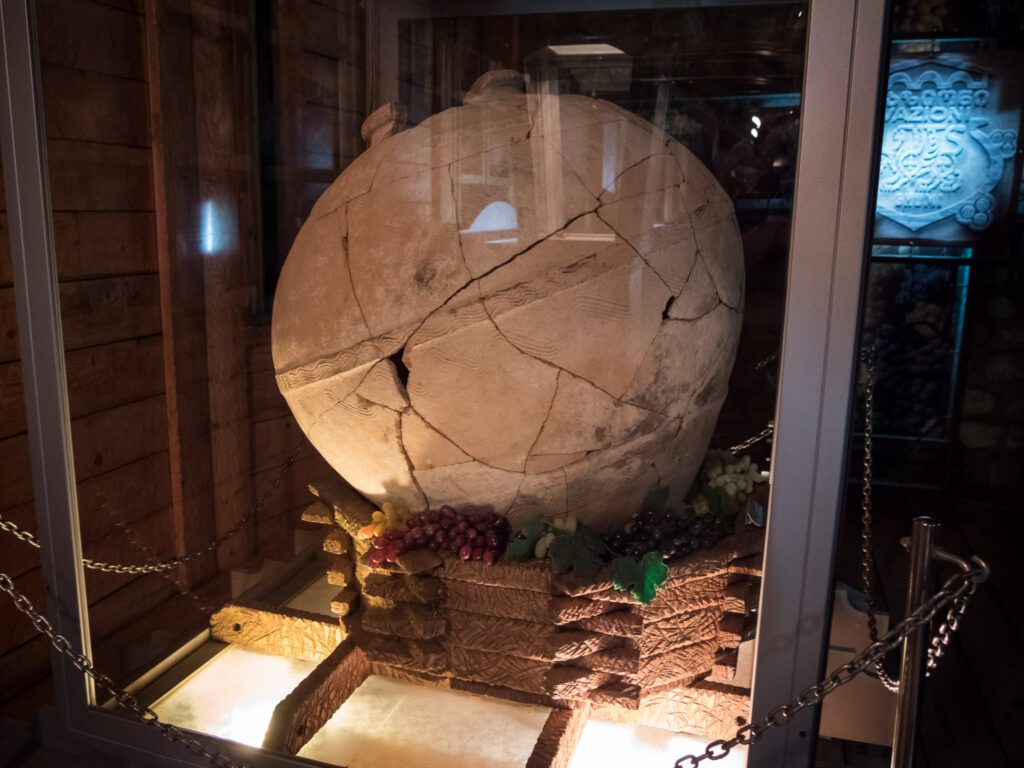
A large corporate winery producing around 2.5 million bottles per year. Though it is certainly growing more touristy, with further development of their tourist facilities constantly, I consider it the most pleasant of the mass-tourism spots, and with some better wines to taste.
On site, you can take an English tour (5 GEL) and visit their:
- Commercial factory.
- Qvevris.
- Wine history museum.
- Grape nursery.
- Cooking masterclass (fees apply).
- Restaurant with reasonable prices. Typical Georgian pub food.
Essentially, all the Georgian activities that you’d find elsewhere, but in more of a production line structure, as you’d expect with mass tourism.
Iberuli Range Tasting = 15 to 40 GEL. The kisi qvevri (or khikhvi, when available) is a genuinely decent example of qvevri amber wine. This wine range is a step above their basic, budget wines.
Once you add up the price of lunch, premium wine tasting, cooking class, museum, the cost of the visit is only marginally lower than going to do a full dinner, artisan wine tasting, and cooking class with a local family. The main draw is really convenience, flexibility, and that groups of 1 to 2 people can attend economically, which is not normally possible at home wineries, who want group bookings.
Located near Telavi, a short taxi ride, find them on Google maps.
Khareba
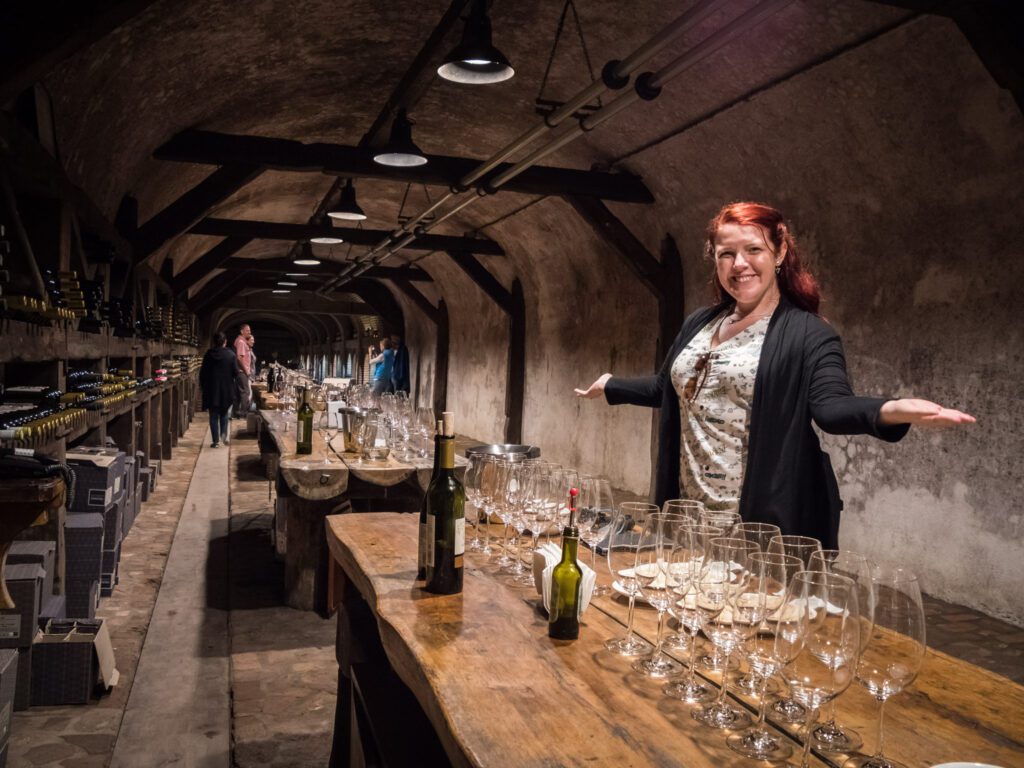
I mentioned above that this is one of the most touristy spots, with average wines. That said, tourists seem to love it (provided they have not experienced the proper family, artisan alternatives).
Like Shumi, they have some cheaper tasting options, cooking classes, easy visits for solo and couples, a restaurant with decent fare, low prices, and nice views. The wine tunnel is genuinely interesting.
Tasting 3 standard wines, and a visit to the wine tunnel, is 25 GEL.
A longer list of wineries is here.
Georgia Wine Tours – Summary
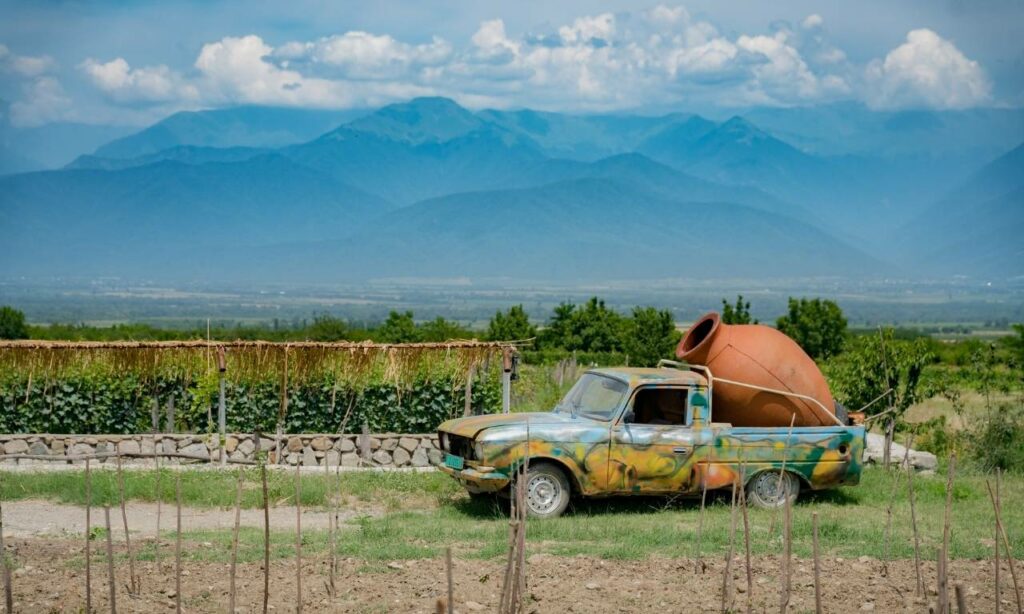
Georgian wine country offers a pretty diverse range of options. Though wine can and is judged objectively, we all have our personal, subjective opinions too. I don’t want to let my bias for unique, once-in-a-lifetime, small-batch artisan wines color the perceptions of your own personal taste.
If you like simple, straightforward reds, for example, you may actually prefer a mid range stainless steel made saperavi, over a vibrant orange peel and walnut-toned qvevri rkatsiteli. I can admit also that my first few experiences with amber wine led to some confusion – is it wine? I drank a lot more red wines initially. But once learning to appreciate and understand the style, it’s now my favorite wine style.
Regardless of your wine preference, If you have flexibility in your budget, attending a supra with a winemaker’s family is always going to be a better and more quintessentially Georgian experience than going to a wine factory/restaurant for a tasting. When the wine has a sense of place, your enjoyment increases.
All my most memorable Georgian experiences (of which I now have many!) have been around a table with winemakers. Sightseeing and museums don’t even come close.
Book a Tour:
- Eat This! Premium Authentic Food & Wine Tours. Premium artisan wines, exceptional experiences and food, tasting/wine pairing menu, real supra (feasts). Indulgent, interactive and personal small group tour experiences.
- Traffic Travel Tours. Traditional home-cooked food, decent family wine and hospitality as well as typical commercial visits. A taste of Georgian wine culture, but not the whole hog.
- Gamarjoba tours. Commercial wineries (Khareba & Kindzmaruli Corporation), larger group but cheap. Meet people, fun day out, limited experience with traditional restaurant food and corporate wine (see my notes on the difference between “artisan”, “factory” and “home” wine below).


